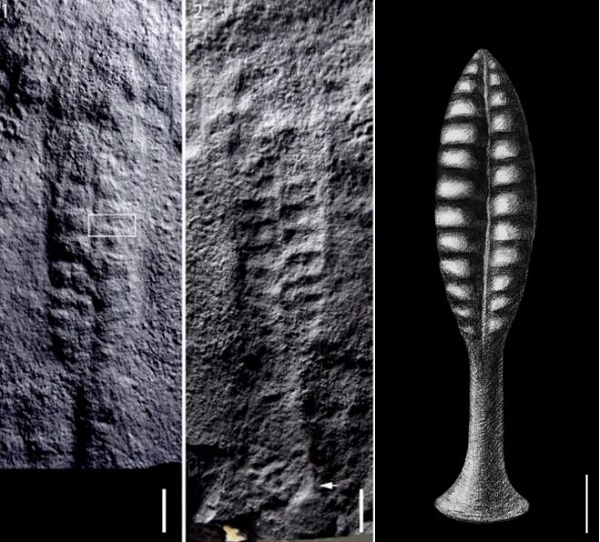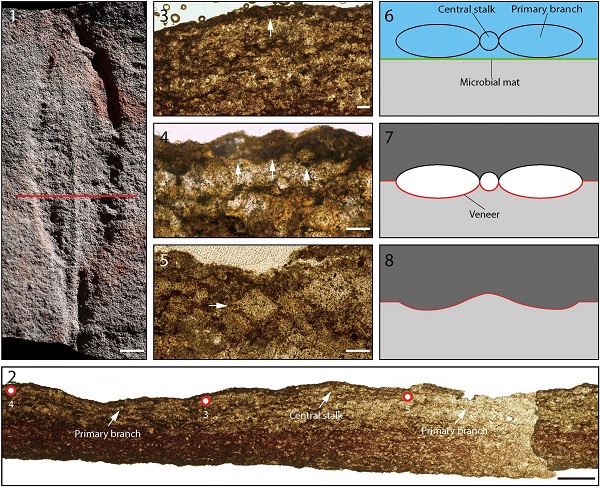Ediacara-type organisms are an assemblage of macroscopic, soft-bodied eukaryotes that are prosperous in the late Ediacaran (~571–539 Ma). They constitute a unique macroscopic fossil biota prior to the Cambrian explosion—the Ediacara biota, representing a landmark in the evolution of early macroscopic organisms.
Probably there is nothing as enigmatic as the iconic frondose fossils in the Ediacara biota. A typical frondose fossil consists of an upright leaf-like body (petalodium), a connecting stem, and a basal attachment disc. Frondose fossils are widespread and abundant in the Ediacara biota. However, due to their simple external morphology and preservation without internal anatomical information, such information about their phylogenetic affinities still limited. Early researchers interpreted them as early pennatula phosphorea according to the similarity of their overall morphology, but ontogenetic and phylogenetic evidence has rejected this hypothesis. Recent studies suggest that these frondose fossils might represent crown- or total-groups of the Metazoa.
In 2014, a type of frondose fossil—Charniodiscus was reported from the Shibantan biota (i.e., the Shibantan assemblage of the Ediacara biota) in the Ediacaran Dengying Formation, Yangtze Gorges area, Hubei, China. However, recent studies have revealed that the type species of Charniodiscus is a frondose fossil with fractal branching and multiple petalodia. Hence, it is questionable to place the frondose fossils from the Yangtze Gorges area in Charniodiscus.
Lately, PhD candidate WANG Xiaopeng, Assoc. Prof. PANG Ke, and Prof. CHEN Zhe et al. from Nanjing Institute of Geology and Palaeontology, Chinese Academy of Sciences (NIGPAS) and Prof. XIAO Shuhai from Virginia Tech scrutinized and revised a major group of frondose fossils from the Shibantan biota. Related results have been published online in Journal of Paleontology recently (free open access).
The study shows that the morphological of the frondose fossils from the Yangtze Gorges area are more similar to Arborea which is a bi-petaloid frondose fossil without fractal branching pattern, rather than the type species of Charniodiscus. As a result, the researchers placed these fronds into Arborea. They identified four species of Arborea from the Shibantan biota, including the type species Arborea arborea, Arborea denticulata new species, and two unnamed species, Arborea sp. A and Arborea sp. B. Biometric and principle component analysis were also conducted, and these results showed that Charniodiscus sp. from the Bonavista Peninsula, Newfoundland, Canada is indistinguishable from Arborea arborea. Therefore, they are synonymized. This research also shows that frondose fossils still have a high diversity even in the latest Ediacaran, providing important evidence for understanding the evolution during the transition between the Ediacaran and Cambrian.
The Shibantan Member in South China and the Khatyspyt Formation in Arctic Siberia represent the only two carbonate successions that are known to host morphologically complex, soft-bodied Ediacara-type macrofossils. This study also includes taphonomic analysis and a model to explain the preservation mechanism of Arborea. authigenic calcite might have played an important taphonomic role in the preservation of Arborea from the Shibantan biota.
This research was supported by the Chinese Academy of Sciences, the National Natural Science Foundation of China, the Chinese Ministry of Science and Technology, the Science Foundation of Jiangsu Province of China, and the State Key Laboratory of Palaeobiology and Stratigraphy.
Reference: Wang, X., Pang, K.*, Chen, Z.*, Wan, B., Xiao, S., Zhou, C., Yuan, X., 2020. The Ediacaran frondose fossil Arborea from the Shibantan limestone of South China. Journal of Paleontology, in press. DOI: 10.1017/jpa.2020.1043.

Arborea deticulata n. sp. from the Shibantan biota

Arborea arborea from the Shibantan biota

Arborea sp. A (1-4) and Arborea sp. B (5-6) from the Shibantan biota

Petrographic observations and proposed preservation mechanism of Arborea
